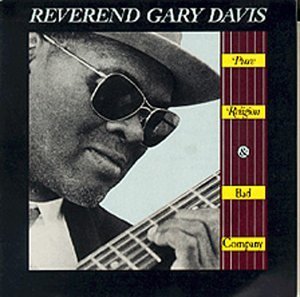Great company
 A Dutch band from the late 70's (Gruppo Sportivo) once wrote a song explaining the rules for making successful Blues. The first 3 rules were:
A Dutch band from the late 70's (Gruppo Sportivo) once wrote a song explaining the rules for making successful Blues. The first 3 rules were:1. Be black
2. Be blind
3. Try to see a lot of misery.
This definitely goes for some of the heroes we talked about earlier. When we turn today to Reverend Gary Davis the link with Fulton Allen (Blind Boy Fuller) and Saunders Terrel (Sonny Terry) is proof of these rules. As you may have read in earlier postings, these 3 representatives of the Piedmont worked a lot together.
Gary Davis was born in 1896 and learned to play the guitar at an early age. So he started out in Ragtime.This might be the reason for his particular 'fingerpicking' style of playing. This style, together with the more mellow approach, as compared to city Blues, makes him one of the great representatives of the Piedmont Blues, together with Sonny Terry, Blind Boy Fuller, Brownie McGhee, Mississippi John Hurt and Skip James. Gary got his nickname 'Reverend' from the fact that he was a Christian minister and showed great interest in gospel. There style of guitar playing influenced a complete generation of Blues and Pop legends (for instance Ry Cooder).
But that isn't the only thing Gary left us when he died in 1972. He also left us a bunch of wonderful compositions. Over the years these have been covered by people like: Bob Dylan, Grateful Dead, Jackson Brown, etc.
Today offering is a original album from 1957. That is..... This post contains 2 bonus tracks that were added later (release 1991). These tracks, however, are from the same recording sessions as the rest of the album.
The password = "scrooge".





